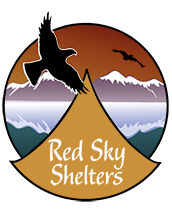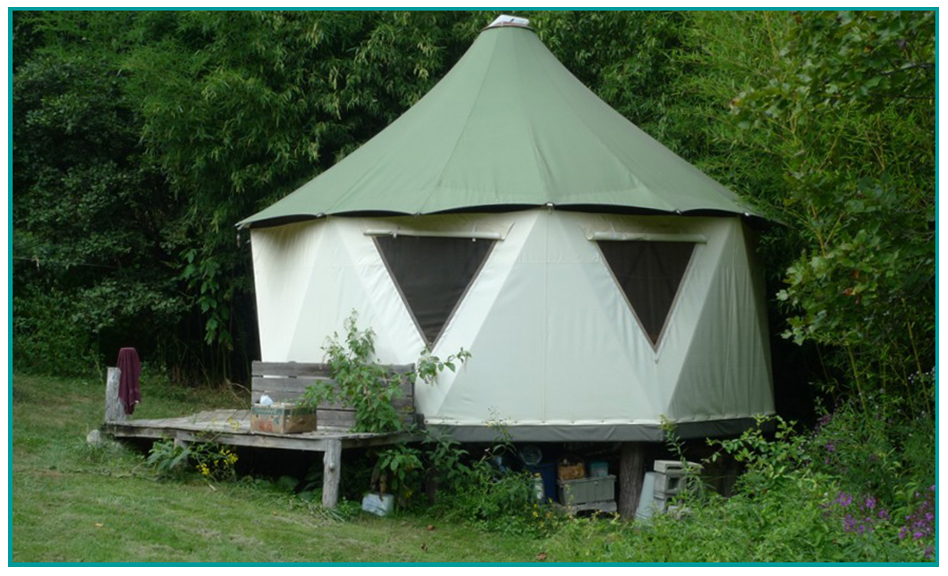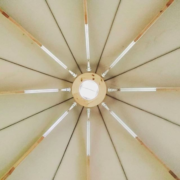The UltraYome™
The UltraYome design launched in the fall of 2019. Benefits of this new design for our OctaYome model include taller walls, higher ceiling, increased roof overhang, a sleek roofline and elegant corkscrew design.
The Ultra (Octa) Yome includes:
Legacy Roof Covering
Radiant Barrier Roof Insulation
Fabric Ceiling Cover
Sunforger Wall Covering
Roof Vent System
Fabric Care Kit
One Triangular Window Covering
One Triangular Window Transparent Vinyl
One Triangular Window Screen
Yellow Pine Support Poles
Hardware and Printed Instructions
Online Assembly Instructions with Videos
Sidewall Height 6’10” Total Height 14’4”
*Note: UltraYomes are available only as an Octa*
Price: $6,460
What’s the difference between the
UltraYome and Classic Yomes?
UltraYome Roof:
The increased amount that the roof overhangs the sidewalls. This keeps most precipitation from dripping onto the walls. Although the classic Yome has more of an overhang than yurts, it isn’t enough to completely keep the drip line away from the walls. Customers wondered why we didn’t just increase the overhang in the classic Yome and the reason was the upward wind load. Increasing the amount of overhang has an exponential affect on the amount of wind the structure has to resist. The UltraYome had to be highly engineered to offer a full overhang while resisting this load. With this UltraYome structure’s ability to flex, absorb and transfer loads, there is not a need for an additional snow load kit. In contrast, yurts require an additional snow load kit consisting of several wood masts under each roof rafter relying primarily on compression to handle the potential additional load. Furthermore, the UltraYome roof has a very steep pitch which allows snow in many cases to slide off.
Improved Ventilation System:
A huge benefit of the UltraYome is its ventilation system. The structure is designed to integrate with the roof insulation to offer a more comfortable shelter. Just like a yurt, one of the challenges a Yome has is to stay cool in hot environments. The roof insulation consists of a draped flame-resistant canvas covering supporting radiant barrier insulation. There is a lot of space between the roof and the insulation which creates an efficient convection current that sends the warm air out the vent in the roof’s apex. Furthermore, this convection current keeps condensation from forming. UV-resistant mesh panels seal the interface between the roof and sidewalls which allows the convection current and keeps insects from entering. In extremely cold situations the mesh can be replaced with insulated panels. However, in all but extreme cold closing the roof vent and the top of the insulation cover should suffice.
Structural Support and a Better Fit:
One of the differences between the UltraYome and the classic Yome is the base corner brackets. In the classic Yome the base plate poles are attached together with eyebolts which results in a gap. Although this gap is sealed with the “fabric flashing” the UltraYome has an adjustable bracketing system that offers a continuous plate at the base corners. These brackets can slide to allow a much easier way of adjusting the fit between the side wall fabric and base plate. In addition, these brackets offer an advanced system to anchor the structure to the platform.
Corkscrew System:
We call the new technique for erecting the Yome the “Corkscrew System” because the structure twists up into the air like a corkscrew using a series of ratcheting pulleys. This means it is actually possible for a single person to lift the entire structure in the air (although we recommend using two people). Furthermore, the roof and most all the hardware can be ergonomically installed while the structure is half way up.
Want to learn more about the UltraYome Design?
It is a true tensile structure. This means that it is a structure that maximizes the efficiency of tension in addition to compression to create an extremely strong structure that uses a minimum of materials. The classic Yome along with yurts have a roof that is draped into the roof rafters. In the UltraYome the roof membrane is lifted off the rafters with a double ring-turnbuckle system. This creates what is known as an anticlastic surface. This harnesses the strength inherent in the flexibility of a membrane that is curved in all directions. Through its shape and flexibility the roof fabric can dynamically respond, absorbing both upward and downward loads and efficiently transfer those loads to a cable that runs around the perimeter. In addition, the structure is radial which allows this perimeter load to be self-supporting. We think this is all really exciting!
Another efficient engineering feature of the UltraYome is its cable-stayed truss system used by all the rafters and top plate poles. Rather than using heavy thick wooden poles, a truss is created where the bottom cord is a steel cable. The result again is an extremely strong support using a minimum of materials. The poles can be fairly lightweight because the part that is under tension is the cable (which is really efficient at handling tension).



